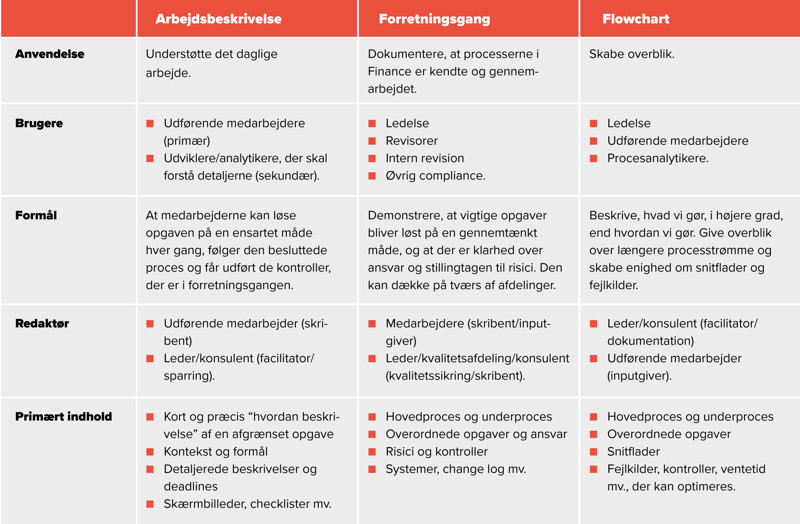Documenting processes in Finance is about much more than describing how you do things today. It is about creating a structure that standardises and thereby supports continuity in the processes, reduces errors and strengthens the foundation for future improvements. In this article, you can learn more about how to structure the documentation task and how it can benefit your organisation.
Continuous improvements that support the business and create increased value are a constant focus area in Finance, and there is often a desire to document the processes.
At the same time, tasks in Finance are often diverse and overwhelming, so it can be difficult to define where a documentation task begins and ends. Therefore, uncertainty about how to approach the task practically can end up being the stumbling block that prevents the work from ever being started.
When executed correctly, the purpose of documenting your processes is to create overview and clarity of all tasks in your finance function and to create robustness and structure that helps you, for example, to identify duplicate work and delaying tasks. It likewise makes you less vulnerable to, for example, staff turnover, restructurings and unforeseen events that result in deviations from the adopted procedures, which increases the risk of errors, reduces efficiency and delays work tasks.
Specifically, with documentation of your workflows you can achieve a foundation for:
Continuity and knowledge transfer: We change jobs more frequently than before. Therefore, it is more important than ever to have documented the desired execution in order to maintain continuity. In this way, you avoid process knowledge being lost when an employee leaves. This is especially important in connection with tasks that only one person handles, because it involves extra vulnerability.
Reduction of errors: By reviewing and documenting the tasks in your processes, you can more easily identify risk sources, i.e., where errors typically arise, and find solutions in the form of strengthened workflows or mitigating controls to reduce these. This improves the quality of the tasks.
Optimisation through insights: With a clear overview of tasks, deadlines, responsibilities and backup personnel, you create a better foundation for optimising, for example, the month-end closing process. The overview provides a shared insight into when what needs to be done and helps support that deadlines are met by ensuring the processes are not designed to create bottlenecks.
Foundation for improvements and automation: When the tasks are documented, you gain a deeper understanding of your processes. This enables an analysis of where there are automation potentials or opportunities to integrate your systems more advantageously. Increased automation can, amongst other things, help employees increase focus on more value-creating activities such as variance explanations and strengthening the control environment, whilst quality becomes predictable as human errors are avoided.
Where does the shoe pinch?
When you are to begin documenting the processes in your organisation, it is important to start by defining the reasons. Because why do you want to have your processes documented at all? Where does "the shoe pinch" due to, for example, delays caused by bottlenecks, errors or identified duplicate work?
The following points are typical concrete challenges we experience at companies where documentation can create more clarity and value:
- Lack of overview of what is controlled and when
- Great variation in task execution, which can create internal confusion
- Difficulties in meeting reporting deadlines from management and authorities
- Error-ridden material delivered to management
- Lack of clarity about areas of responsibility between departments
- Delayed receipt of material from other departments due to unclear deadlines.
Use the right documentation format
When you have defined the core challenges, you can much more easily define which documentation format is relevant and adequate for your needs. There are three different forms of process documentation which it is important to distinguish between, and which have different focus areas and levels of complexity: work descriptions, business process descriptions and flowcharts.
Types of process descriptions

(Only available in danish)
Work descriptions:
Also known as a Standard Operating Procedure and used to ensure that a task is performed consistently, regardless of whether the executing person changes.
The work description contains context and purpose for the given task with detailed descriptions, step-by-step instructions as well as relevant screenshots, checklists etc. This makes it possible to identify the right process that ensures compliance with the applicable controls in the business process.
The work description is formulated by the executing employee in collaboration with the relevant manager.
It is often best to wait with detailed work descriptions until the process is stabilised, so you avoid updating the documentation constantly.
Business process descriptions:
Business process descriptions are used for more formal documentation.
The level of detail is lower than in a work description, but covers a larger part of the process and provides a good overview of system usage, role and responsibility distribution and connections between risks and controls.
These will typically be what you show to authorities and auditors when you need to formally demonstrate that you have control of your processes and controls. Therefore, the quality of business process descriptions is typically ensured by the relevant management or a dedicated quality department.
Flowcharts:
If you want to get control of your control environment, flowcharts are a good place to start.
They provide a visual overview of role and responsibility distribution and help identify where risks and controls are located, whilst interfaces between different departments, where errors can occur, are identified.
Put simply, flowcharts help to a greater extent to describe what you do, rather than how you do it.
If you experience many errors or have difficulty meeting deadlines, flowcharts can also help. Here the focus will be on waiting time, setbacks and other inefficiencies in the process. Through an analysis, you can identify problem areas and plan initiatives to rectify the process.
These will typically be what you show to authorities and auditors when you need to formally demonstrate that you have control of your processes and controls. Therefore, the quality of business process descriptions is typically ensured by the relevant management or a designated quality department.
How you approach the documentation
Can you achieve all the benefits at once? The answer is no, but you do not need to either. Just as you eat an elephant one bite at a time, you should also take the documentation work in stages.
Begin with the area where you experience the greatest challenges. If your processes are vulnerable to resignations, it is obvious to focus on work descriptions. If, on the other hand, you have general problems with one or more processes, it may be most effective to gather key personnel and map the process together in a flowchart. This creates a shared understanding and makes it easier to find solutions.
To ensure that the documentation work becomes a success, there are several things you should consider:
- Establish standards: Decide how you talk about processes in terms of, for example, symbols, level of detail and roles. Create templates for work descriptions so the format is consistent and easy to understand. Skipping this is equivalent to preparing accounts without standards.
- Choose the right tool: Consider whether the task is best solved with Word, Visio or Excel, or whether you need system support. For documentation of single or few processes, the aforementioned are often sufficient. If, on the other hand, you need to document and improve several processes on an ongoing basis, dedicated process management software such as Process Manager can be a good investment.
- Training of employees: Ensure that employees are equipped to participate in the documentation work. When they have learnt to read and document a process, understand the standard, and can use the tool, and when they know what you expect of them as a leader regarding updating and developing the processes going forward, you give them an opportunity to contribute effectively and understand how they should use the documentation going forward.
- Create a plan and prioritise: Define which processes should be documented first, based on the most pressing needs.
Keep the documentation up to date
One of the most decisive factors for ensuring that the documentation remains relevant and usable is continuous focus from management's side. Employees who are familiar with their tasks rarely consult the documentation every time they perform a task. When changes then arise – either externally or internally in the company – that require adjustments to the process, there is a risk that employees make individual adaptations without updating the documentation.
To avoid this, it is essential that a responsible person at an appropriate level in Finance establishes a setup for follow-up, where employees have responsibility for specific processes and regularly review the documentation to ensure that it is up to date. Changes to a process should be communicated clearly to all involved. This can happen via email or at departmental meetings, depending on how many are affected and how extensive the change is. A process that is only performed once a year naturally does not need to be reviewed quarterly. Conversely, a new process that is used frequently should be reviewed more often, as there will typically be many adjustments and improvements in the beginning.
It will never become exciting to read through documentation solely for the sake of reading through it. Therefore, it may be worth considering setting concrete goals for the review. For example, you can encourage employees to identify parts of the process that are vulnerable, unnecessarily complex or manually intensive during each review. In this way, you actively engage in finding improvement opportunities and create a culture where continuous optimisation is in focus.

Are you ready to formalise your Finance processes?

 en
en
 da
da



